#ring with scarab bezel
Explore tagged Tumblr posts
Text
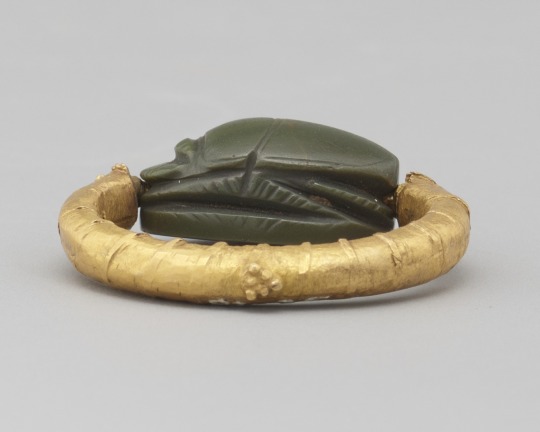
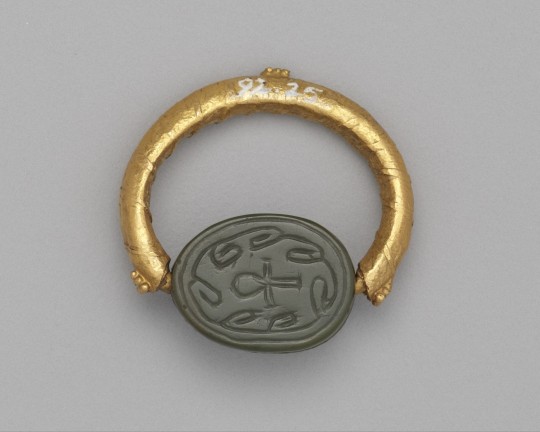
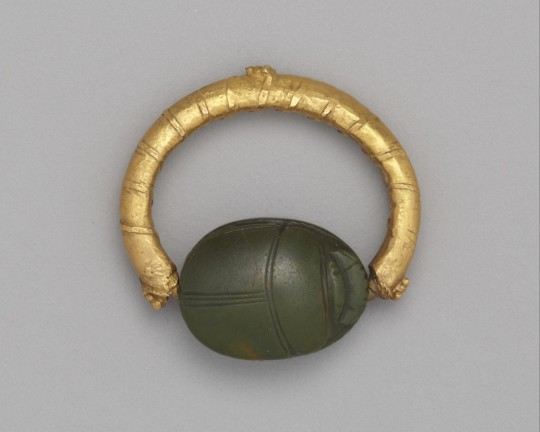

~ Ring with a Scarab Bezel.
Place of origin: Egypt
Date: 1985–1550 B.C.
Medium: Gold and green jasper.
#ancient#ancient art#history#museum#archeology#ancient egypt#ancient history#archaeology#ancient jewelry#ring#ring with scarab bezel#scarab#gold#green jasper#1985 b.c.#1550 b.c.
1K notes
·
View notes
Text


Scarab with "Udjat" Eyes
Canaanite, 1648-1539 BCE (Second Intermediate Period; MB IIB)
This steatite scarab is the bezel of a finger ring. Its flat underside is incised with a vertically arranged design of a pair of facing, connected "Udjat" eyes with script signs below. The design of the back of the scarab is simple with short and aligned carved side-notches and a well proportioned layout. The workmanship of the piece is slightly rough and it is not very carefully made.
29 notes
·
View notes
Text

Gold Scarab Ring
New Kingdom, 18th to 20th Dynasty, ca. 1550-1069 BC. Bequest of Eva Catherine Brown. Now in the Cleveland Museum of Art. 1936.653
Ancient Egyptian turquoise faience scarab (mounted on swivel bezel in modern gold ring). From the end of the third millennium B.C., the scarab beetle served as an amulet in Egypt where it represented the sun god.
The scarab integrated into a gold ring appears in the fourth century B.C. The articulation of the insect and the embellishment of the box reveal craftsmanship of the highest order.
Scarab rings with thicker hoops developed during the Second Intermediate Period. The scarab itself was mounted with a gold wire running through its centre on which it could swivel. As well as gold, silver and electrum were used. They were popular during the New Kingdom period and were worn by both men and women.
Read more
32 notes
·
View notes
Photo

Scarab of Thutmose III Mounted in Ring, ca. 1479-1425 B.C.E., Brooklyn Museum: Egyptian, Classical, Ancient Near Eastern Art
Gold ring with green glazed steatite scarab set in a gold swivel bezel. The base of the scarab has the name Menkherperre written upon it twice. Condition: Glaze on the scarab worn in spots. Small nicks in the gold. Size: 1 1/16 × 15/16 in. (2.7 × 2.4 cm) Medium: Steatite, glaze, gold
https://www.brooklynmuseum.org/opencollection/objects/4090
18 notes
·
View notes
Photo

Ring with a Scarab Bezel, Ancient Egyptian, -1985, Art Institute of Chicago: Arts of Africa
Gift of Charles L. Hutchinson Size: 1.2 × 2.5 × 2.3 cm (1/2 × 1 × 7/8 in.) Medium: Gold and green jasper
https://www.artic.edu/artworks/594/
8 notes
·
View notes
Photo

Finger-ring of gold decorated with the figure of a frog, comprised of a hollow shank with tapered ends threaded through the bezel and wrapped around the shoulders : Ancient Egyptian, Middle Egypt, Amarna, probably the Royal Tomb, New Kingdom, 18th Dynasty, reign of Akhenaten, c.1353-1336 BC. Source: National Museum of Scotland #ancientring #Egypt#AncientEgyptian #JewelryAncientEgyptian #Jewelleryancientegyptian #ringsancientegyptian #scarabsrings#scarabs#16thcentury #15thcentury #14thcentury #newkingdom #jewellerybloger #instajewelry #egyptological #egyptianjewelry #tutankhamón (at National Museum of Scotland) https://www.instagram.com/p/B9j2yt2BHP-/?igshid=2fieouu0gqop
#ancientring#egypt#ancientegyptian#jewelryancientegyptian#jewelleryancientegyptian#ringsancientegyptian#scarabsrings#scarabs#16thcentury#15thcentury#14thcentury#newkingdom#jewellerybloger#instajewelry#egyptological#egyptianjewelry#tutankhamón
15 notes
·
View notes
Link
Check out this listing I just added to my Poshmark closet: Vintage 14K Scarab Ring | Carved Carnelian | Turn of the Century Scarab Ring.
0 notes
Text
With A Little Touch Of Historical Ring, Your Look Will Be More Classy
Rings have been around for over 6,000 years and may be found in practically every civilization on the planet. Rings have served a variety of purposes, both functional and symbolic, in addition to serving purely ornamental needs. Rings have been used to seal correspondences, certify documents, and promise one heart to another. They've been used to commemorate friendships, respect the dead, and function as talismans to ward off evil forces. Rings have often been employed as tangible evidence of power and wealth or as metaphorical statements of religion. Historical Ring from all times have survived, providing great historical insight into many societies as well as serving as a timeline of major events.
HISTORICAL RING FROM THE ANCIENT AND CLASSICAL ERAS
Scarab rings, carved from a range of stones such as lapis lazuli, amethyst, rock crystal, and turquoise, and linked simply with silver or gold wire, are known to have been worn by ancient Egyptians. They were frequently carved with decorative hieroglyphs, protective symbols, or titles on the flat side of the scarab; with a simple swivel, the function of both signet and amulet were united.
Egyptian goldsmiths had evolved to casting all metal stirrup-shaped rings carrying the royal cartouche during the New Kingdom period (1559-1085 B.C.). These rings were used to verify documents as well as function as visual markers of position and power. Egyptians wore rings as signets or for religious and talismanic purposes, and despite the beautifully crafted materials and pleasing arrangements of stones and motifs, they were worn for a purpose rather than for decoration.
Rings were worn by the ancient Greeks and Romans for a number of reasons, including solely decorative ones. The Greeks used scarab rings and signet rings etched with natural motifs and figures from mythology and literature. Plain gold rings, as well as bezels set with jewels esteemed for their beauty, rarity, and talismanic abilities, were worn. Wire, filigree, and complex pierced work might also be used to create decorative rings (opus interrasile).
The first rings were made of iron and employed as seals in early Rome, under the Roman Republic. The jus annuli aurei, or right to wear gold rings, was originally granted only to senators and only while acting as ambassadors of the Republic. All civilians eventually gained the right to wear gold rings. Both men and women began to wear massive gold rings set with rare and costly stones in increasingly more apparent displays of wealth and position throughout the later years of the Roman Empire. While wearing more than one ring was originally uncommon, by the first century AD, each finger may be encrusted with many adornments.
Rings were typically carved with appropriate symbols such as representations of Eros or Aphrodite as mementos of affection and love among the Greeks. The practise of exchanging rings as betrothal tokens, on the other hand, is thought to have started with the Romans.
The right hands clasped in symbolic depiction of marriage and faithfulness, known in Latin as dextrarum iunctio, was frequently included on Roman wedding rings. The right hand was devoted to Fides, the deity of faithfulness, in Roman symbolism; the theme reappears in the Middle Ages as the fede ring. The betrothal ring was worn on the fourth finger of the left hand, according to ancient writings, in the idea that this finger contained a vein, the vena amoris, that flowed directly to the heart. The marriage knot or knot of Hercules, a simple and symbolic design of two entwined ropes that is presumably the origin of the phrase "tying the knot," was another motif used for betrothal rings.
The signet ring is perhaps the most famous ring style associated with the Romans. The richness of Rome drew the brightest and most skilled artists to carve and set stones, according to Diana Scarisbrick. Official documents were sealed with signet rings, which had gemstone intaglios engraved with the wearer's picture. They were also worn primarily for decoration, and were frequently big and ornate. Themes that were popular included aspects of ordinary life, gods and kings, and portraits of poets and philosophers. Another popular motif was love, and intaglios of lovers' heads facing each other were used in signet rings as marriage rings. Here is historical rings for sale.
Girati offers you a large range of handmade designed historical ring, Beautifully crafted and engraved with historical designs. Take a look on our Renaissance Rings, imperio collection, vintage mens jewelery and many more.
0 notes
Photo
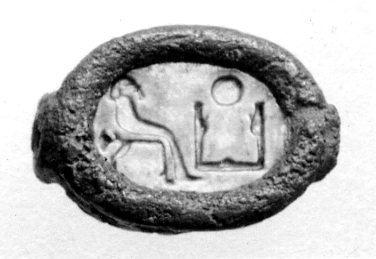
Scarab in a Ring Bezel, Egyptian Art
Medium: Glazed steatite, silver
Purchase, Edward S. Harkness Gift, 1926 Metropolitan Museum of Art, New York, NY
http://www.metmuseum.org/art/collection/search/552918
1 note
·
View note
Text
Ring And Its Many Symbolic Functions
New Post has been published on https://www.inspiredbycreativityjewels.co.uk/ring-and-its-many-symbolic-functions/
Ring And Its Many Symbolic Functions


Image by/from ネックレス
A ring is a round band, usually of metal, worn as ornamental jewellery. The term “ring” by itself always denotes the finger ring, but when worn as an ornament elsewhere, the body part is always specified, e.g. earrings, neck rings, arm rings, and toe rings. Rings always fit snugly around or in the part of the body they ornament, so bands worn loosely, like a bracelet, are not rings. Rings may be made of almost any hard material: wood, bone, stone, metal, glass, gemstone or plastic. They may be set with gemstones (diamond, ruby, sapphire or emerald) or with other types of stone or glass.
Although people wear some rings as mere ornaments, or as conspicuous displays of wealth, rings have symbolic functions in relation to marriage, exceptional achievement, high status or authority, membership in an organization, and the like. Rings can be made to sport insignia to be transferred in an impression in a wax seal, or outfitted with a small compartment in which to conceal things. In myth, fable, and fiction, rings are often endowed with spiritual or supernatural significance.
Along with the rings, other types of jewelleries including necklace, rings, bracelets, earrings, bangles, pendants, and others have been discovered from 3rd millennium BC civilization Indus Valley Civilization. Factories of small beads have been discovered in Lothal, India.
Finger rings have been found in tombs in Ur dating back to circa 2500BC. The Hittite civilization produced rings, including signet rings, only a few of which have been discovered. People in Old Kingdom Egypt wore a variety of finger rings, of which a few examples have been found, including the famous scarab design. Rings became more common during the Egyptian middle kingdom, with increasingly complex designs. Egyptians made metal rings but also made rings from faience some of which were used as new year gifts. Native styles were superseded by Greek and Roman fashions during the Ptolemaic dynasty.
Archaic Greek rings were to some extent influenced by Egyptian rings, although they tended to be less substantial and were not for the most part used as working signet rings. A lack of locally available gold meant that rings made in the eastern colonies tended to be made from silver and bronze while Etruria used gold.
The classical period showed a shift away from bronze to wider adoption of silver and gold. The most typical design of the period involved a lozenge bezel mounting an intaglio device. Over time the bezel moved towards a more circular form.
During the early and middle imperial era (first two centuries AD) the closest there is to a typical Roman ring consisted of a thick hoop that tapered directly into a slightly wider bezel. An engraved oval gem would be embedded within the bezel with the top of the gem only rising slightly above the surrounding ring material. Such rings are referred to Henig II and III/Guiraud 2 in formal academic parlance or simply as Roman rings by modern jewellers. In general Roman rings became more elaborate in the third and fourth centuries AD.
During this period the fashion was for multiple rings on each hand and on each finger. Rings during this period were mostly made from copper based alloys, silver or gold. Gems became common after 1150 along with the belief that certain gems had the power to help or protect the wearer in various ways. Engraved rings were produced using Lombardic script until around 1350 when it was replaced by Gothic script. Some of the inscriptions were devotional, others romantic in nature. For romantic inscriptions French was the language of choice. An increasing use of contracts and other documents that needed to have formal seals meant that signet rings became more important from the 13th century onwards.
Each finger has had a symbolic association or meaning (most lost in antiquity and that may vary from culture to culture) for the placement of a ring as a sign to observers.
The fourth digit or ring finger of the left hand has become the customary place to wear betrothal, engagement and wedding rings in much of the world, though in certain countries the right hand finger is used. This custom was practically established as the norm during World War II.
The use of the fourth finger of the left hand (the ‘ring finger’) is associated with an old belief that the left hand’s ring finger is connected by a vein directly to the heart: the vena amoris or vein of love. This idea was known in 16th and 17th century England, when Henry Swinburne referred to it in his book about marriage. It can be traced back to ancient Rome, when Aulus Gellius cited Appianus as saying the ancient Egyptians had found a fine nerve linking that particular finger to the heart.
Occasionally rings have been re-purposed to hang from bracelets or necklaces.
The signet ring is traditionally worn on the left pinky or little finger.
A birthstone ring and/or “birthday” stone ring is customarily worn on the first finger of the right hand and indicates respectively the month and day of the week in and on which the bearer was born.
Amulet rings, worn for a plethora of purposes from protection (pentacle rings) to augmenting personal attributes (wisdom, confidence, social status etc.) are worn on various fingers often depending on the intent of the ring’s design or attributes of the stone inset. Although it has been thought that worn on specific fingers for specific purpose enhanced their powers, most people simply wear them on any finger of which they fit.
Thumb rings were originally worn to protect the thumb from injuries caused by the launching of arrows and are a sign of an archer.
While the ISO standard defines ring size in terms of the inner circumference in millimeters various countries have traditional sizing systems that are still used. Sizing beads functionally reduce the ring size and are small metal beads added to the inner surface of a ring to hold it in place against the finger; they have the advantage of being easily added or removed.
After several thousand years of ring manufacture the total number of styles produced is vast. Even cataloging the rings of a single civilization such as the Romans presents a major challenge. As a result, the following list should be considered to be very limited.
0 notes
Photo
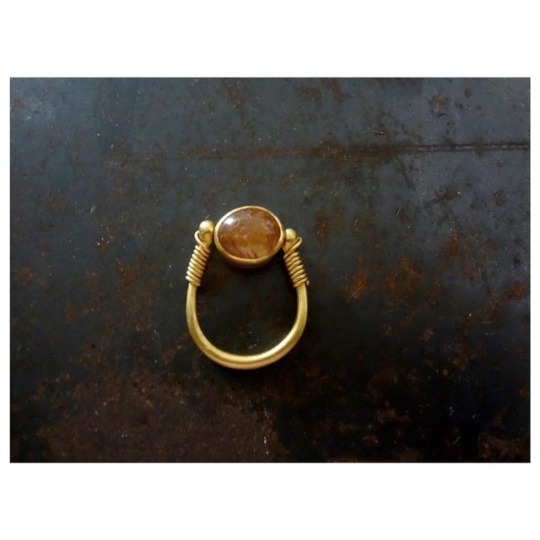
Spinny ring based on ancient scarab rings. Rutilated Quartz bezel set 22k gold flips over to plain gold side. I like making and wearing rings.. . . . . . #madeinnyc #studiowork #design #fashion #ootd #gemstones #realgold #designer #mystyle #jewelrygram #shopping #nycstyle #design #style #madebyhand #aesthetic #photography #genderless #weddingband #jewelrymaking #jewelry #menstyle #documentinglife #productphotography #fashionstyle #wabisabi #meditative #designthinking #unisexstyle #fashionstyle #signetring #menrings #goldrings (at New York, New York)
#ootd#productphotography#menstyle#documentinglife#unisexstyle#studiowork#fashion#jewelry#fashionstyle#jewelrygram#signetring#designer#goldrings#weddingband#wabisabi#gemstones#designthinking#aesthetic#photography#menrings#madebyhand#design#realgold#mystyle#meditative#genderless#nycstyle#jewelrymaking#shopping#style
1 note
·
View note
Text

Scarab Ring
Egyptian, 1388-1351 BC (New Kingdom)
The hoop of this turquoise-colored faience ring ends in lotus blossoms; the bezel is in the form of a scarab.
16 notes
·
View notes
Photo
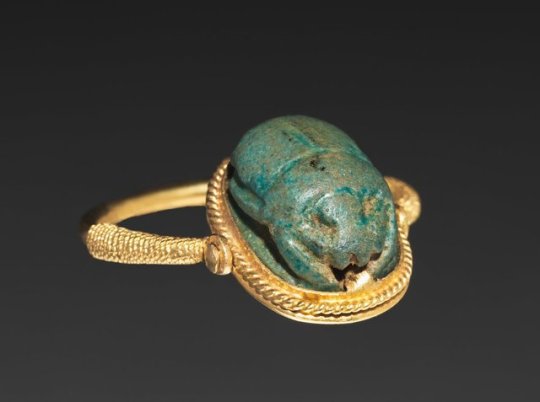
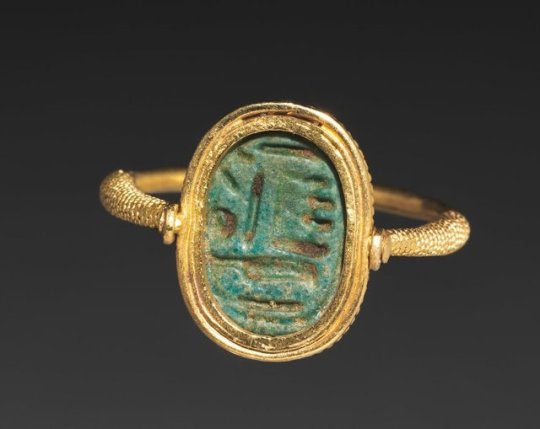
Ancient Scarab in a Modern Ring
Turquoise faience: Egypt, New Kingdom, 1540-1069 BC (mounted on swivel bezel in a modern gold ring)
Cleveland Museum of Art
418 notes
·
View notes
Photo
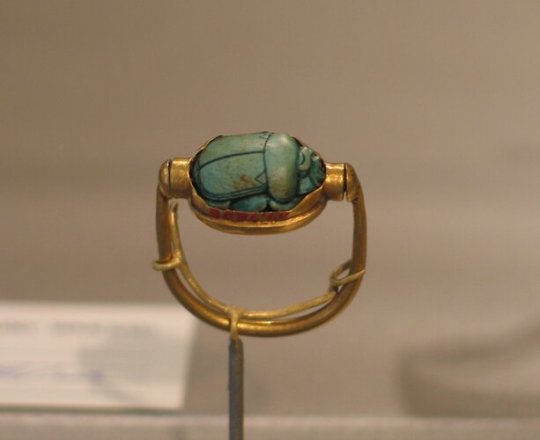
Scarab of Thutmose III Mounted in Ring, ca. 1479-1425 B.C.E., Brooklyn Museum: Egyptian, Classical, Ancient Near Eastern Art
Gold ring with green glazed steatite scarab set in a gold swivel bezel. The base of the scarab has the name Menkherperre written upon it twice. Condition: Glaze on the scarab worn in spots. Small nicks in the gold. Size: 1 1/16 × 15/16 in. (2.7 × 2.4 cm) Medium: Steatite, glaze, gold
https://www.brooklynmuseum.org/opencollection/objects/4090
3 notes
·
View notes
Photo
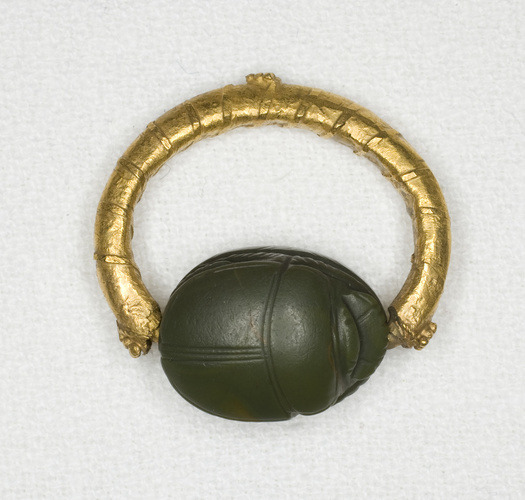
Ring with a Scarab Bezel, Ancient Egyptian, -1985, Art Institute of Chicago: Arts of Africa
Gift of Charles L. Hutchinson Size: 1.2 × 2.5 × 2.3 cm (1/2 × 1 × 7/8 in.) Medium: Gold and green jasper
https://www.artic.edu/artworks/594/
5 notes
·
View notes
Photo

Gold Finger Ring with Image of Amun-Re on Cartouche-shaped Bezel, Gold Finger Ring with Engraved Sun Boat and 2 Adoring Baboons on Bezel Discovered in the Valley of the Kings in Luxor,Egypt in 1922. Artefacts moved to the EgyptianMuseum in Cairo at the time of excavation. The entire collection is currently in the process of transferring to the Grand Egyptian Museum inCairo. Inventory: JE 62451 SR 1/ 3349 Carter 44-f GEM 138 Title: Gold Finger Ring with Image of Amun-Re on Cartouche-shaped Bezel Date: 18th Dynasty of the New Kingdom Medium: Gold Size: L 2.50 cm W 1.10 cm Max D 2.2 cm #BritishMuseum #egyptianmuseum #easter #MuseumFromHome #bkmegyptianart #ancientring #Egypt#AncientEgyptian #JewelryAncientEgyptian #Jewelleryancientegyptian #ringsancientegyptian #scarabsrings#scarabs#16thcentury #15thcentury #14thcentury #newkingdom #jewellerybloger #instajewelry #egyptological #egyptianjewelry #tutankhamón (at Grand Egyptian Museum) https://www.instagram.com/p/B_koKDYh4sH/?igshid=2vp94nq1pdbh
#britishmuseum#egyptianmuseum#easter#museumfromhome#bkmegyptianart#ancientring#egypt#ancientegyptian#jewelryancientegyptian#jewelleryancientegyptian#ringsancientegyptian#scarabsrings#scarabs#16thcentury#15thcentury#14thcentury#newkingdom#jewellerybloger#instajewelry#egyptological#egyptianjewelry#tutankhamón
0 notes